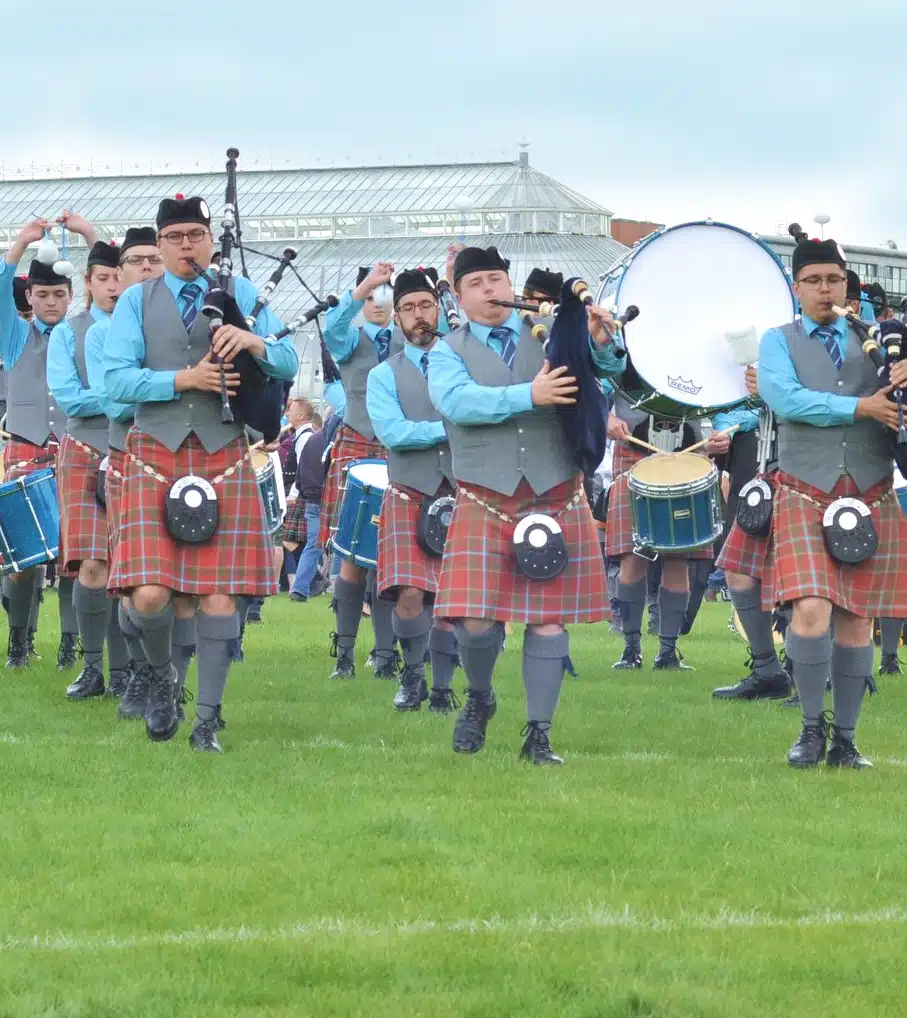History of Bagpipes
| The Evolution of the Great Highland Bagpipe by Robert Worrall |
 Scotland’s national instrument, the Bagpipe or in Gaelic “piob-mhor” (the great pipe) is not, contrary to popular belief, an instrument which has its origins in and has diffused from Scotland. The bagpipe is an instrument of great antiquity, an instrument which has its origins in the Middle East and traveled through and evolved in Europe alongside the diffusion of early civilization. The “Oxford History of Music” makes mention of the first documented bagpipe being found on a Hittite slab at Eyuk. This sculptured bagpipe has been dated to 1,000 B.C. Biblical mention is made of the bagpipe in Genesis and in the third Chapter of Daniel where the “symphonia” in Nebuchadnezzar’s band is believed to have been a bagpipe. These early pipes or “Pan” pipes, without the bag or reservoir, were probably the second musical instrument to evolve. Musical history dictates that pipers have to take a back seat to percussion instruments in this case. These early pipes used materials with a natural bore (hollow reeds, corn stalks, bamboos, etc.) Scotland’s national instrument, the Bagpipe or in Gaelic “piob-mhor” (the great pipe) is not, contrary to popular belief, an instrument which has its origins in and has diffused from Scotland. The bagpipe is an instrument of great antiquity, an instrument which has its origins in the Middle East and traveled through and evolved in Europe alongside the diffusion of early civilization. The “Oxford History of Music” makes mention of the first documented bagpipe being found on a Hittite slab at Eyuk. This sculptured bagpipe has been dated to 1,000 B.C. Biblical mention is made of the bagpipe in Genesis and in the third Chapter of Daniel where the “symphonia” in Nebuchadnezzar’s band is believed to have been a bagpipe. These early pipes or “Pan” pipes, without the bag or reservoir, were probably the second musical instrument to evolve. Musical history dictates that pipers have to take a back seat to percussion instruments in this case. These early pipes used materials with a natural bore (hollow reeds, corn stalks, bamboos, etc.) The Roman bagpipes or “tibia utricularis” represented a major innovation, the addition of the reservoir. Historians have noted that Roman coins depict Nero playing the bagpipe, not the fiddle. The early “Dudel-Sack” gave rise to a number of European, Asian and African folk bagpipes, namely, the Volynka (U.S.S.R.), the Bock (German), the Zukra (North Africa), the Gaita (Portugal and Spain), the Zampogna (Italy), the Cornemuse (France), the Moshug (India), the Zumarah (Egypt), and Flemish, Polish, Greek and Hungarian examples. An extensive and thoroughly documented collection of these instruments can be found in the Musical Instrument section of the Metropolitan Museum of Art in New York City. In addition, examples of early folk bagpipes can be found in the paintings of Breughel, Teniers, Jordaens and Durer. The French Musette An Early Bagpipe (Van Dyck) The French Musette can be seen as a logical explanation for the evolution or refinement of the instrument into a number of examples of chamber pipes (i.e. those that operate via the use of bellows rather than the tradition bags as a reservoir). Examples of different forms of such chamber pipes can be found throughout Ireland, France and England. The Northumbrian region of England has been a “hotbed” for bagpipe evolution. It has not only witnessed the emergence of its indigenous shuttle pipes, but also its own small pipes, half longs and great war-gathering pipes. Likewise, Ireland has experience the evolution of its own Uillean (chamber/bellows pipe) and war pipe (Brian Boru). The evidence exists to substantiate the belief that pipes may have been common throughout the remainder of Britain prior to their to emergence upon the Scottish landscape. Nevertheless, there is no question that the Bagpipe was very popular throughout England. Middle Ages Pre-Reformation churches reveal carvings of bagpipes. Chaucer refers to the Miller playing pipes in “The Miller’s Tale”, Documents from the Lord High Treasurer of Scotland (1498 and 1506) refers to payments to the English piper. Shakespeare’s “Henry IV” refers to the “Drone of a Lincolnshire Bagpipe”. The Irish are believed to have played pipes for Edward I at Calais in 1297 and at the Battle of Falkirk in 1298. In fact, both Henry VII and Henry VIII are believed to have enjoyed pipers. Chaucer’s Miller (14th Century Drawing) Questions remain as to when and where the first, second and third drones were added to the “piob-mhor” along with the questions as to when and where the bagpipe entered Scotland. However, the fact remains that this is an instrument whose growth and movement parallel civilizations and early history. It is a musical instrument which not only reflects our early history, but also the evolution of culture through history. Robert Worrall, a piping adjudicator throughout North America, resides in Burlington, Ontario. He was a seven time winner of the North American Open Professional Championships. In 1977 he won the March, Strathspey and Reel competition at Inverness, Scotland. He recorded his first solo album, “The Classic Bagpipe” in 1982. He presently spends much of his time pipe tutoring, teaching workshops and judging. He is a member of the R.S.P.B.A. Panel. |
| Bagpipe History by John White In all of the times I have told people that I play the bagpipes, I have never been asked what kind of bagpipes I play. This might have something to do the with the fear that most people have of getting into conversations with others about their hobbies, but is also suggests that people don’t know what a wide variety of bagpipes there are, and what an expansive history pipes have. The truth is that the first piper had no idea where Scotland was, and that he was probably playing something that looked more like a stuffed dog than a Scottish bagpipe. Modern Scottish Highland Bagpipes The pipes, which most Americans are familiar with, are the Scottish Highland Bagpipes. These pipes have three drones that come out the top of the bag which produce a constant sound, a single chanter with the nine notes of the pipe scale are played one, and a bag made of sheep or elk skin which the piper presses with his arm when he wants to take a breath. This is what makes pipe music free from pauses. The Highland Pipes are only one of the over thirty different kinds of bagpipes that have appeared throughout the world. The Spanish, French, Italians, Germans, Hungarians, Czechoslovakians, Tunisians, Indians, Greeks, and a myriad of other cultures have developed bagpipes of their own. These bagpipes have any number of drones, up to eight coming out the top, bottom, or side of the bag. Among the more famous bagpipes outside the British Isles are the Spanish Galicia which is like the Scottish bagpipe as far as the bag and air supply, but only have one drone. The French Musette which has keys on the chanter and a billow to keep the bag full. And the Zampongno from Italy which has two chanters. Although the existence of the bagpipes before the first century is thought to be documented by the Greek playwright Aristophanes in his work The Acharnians where he wrote, “You pipers who are here from Thebes, with bone pipes blow the posterior of a dog,” there is no solid indications until the first century when a very famous piper came to rule Rome. Nero considered himself a good piper as well as many other things. He even had the bagpipes put on a coin. “They say he can…play the aulos both with his mouth and also with his armpit, a big bag being thrown under it, in order that he might escape the disfigurement of Athens,” Dio Chrysostom wrote in 115 AD. This was one of the first positive references to the bagpipes. Nero also used bagpipes to inspire his troops before battle, though at that time they were generally recognized as peasant entertainment. Soon after the first century we can find traditions of bagpipes stretching all the way from India to Spain and from France to Egypt. We can surmise bagpipes were present in England in the 14th century when Chaucer wrote his Canterbury tales, for Chaucer’s miller, “A bagpipe well couth he blowe and sown.” When they arrived to Scotland, they quickly became a part of Scottish life. Every town would hire a bagpiper, usually out of special taxes from the wealthy families in the area, who would pipe for townspeople on all occasions. In some places the piper would play in churches in place of an organ. As time went on, the bagpipes in the British Isles evolved and various types of pipes and piping were developed. Marches, strathsplays, hornpipes, and reels were perfected and played on the Highland Bagpipes, the Lowland Bagpipes, the Northumbria pipes, and the Irish Union pipes. Modern Shuttle Pipes The Scottish people have made the bagpipes one of the outstanding parts of their culture. In some many songs, stories, and poems, the Scots have celebrated their pipes, and unlike many other cultures they have kept the pipes alive as part of their musical tradition. But still, if you don’t have a great Uncle Fergus from Ayr who played the Lowland pipes, you might have an Uncle Garcia from Madrid who played the Gaita. |
